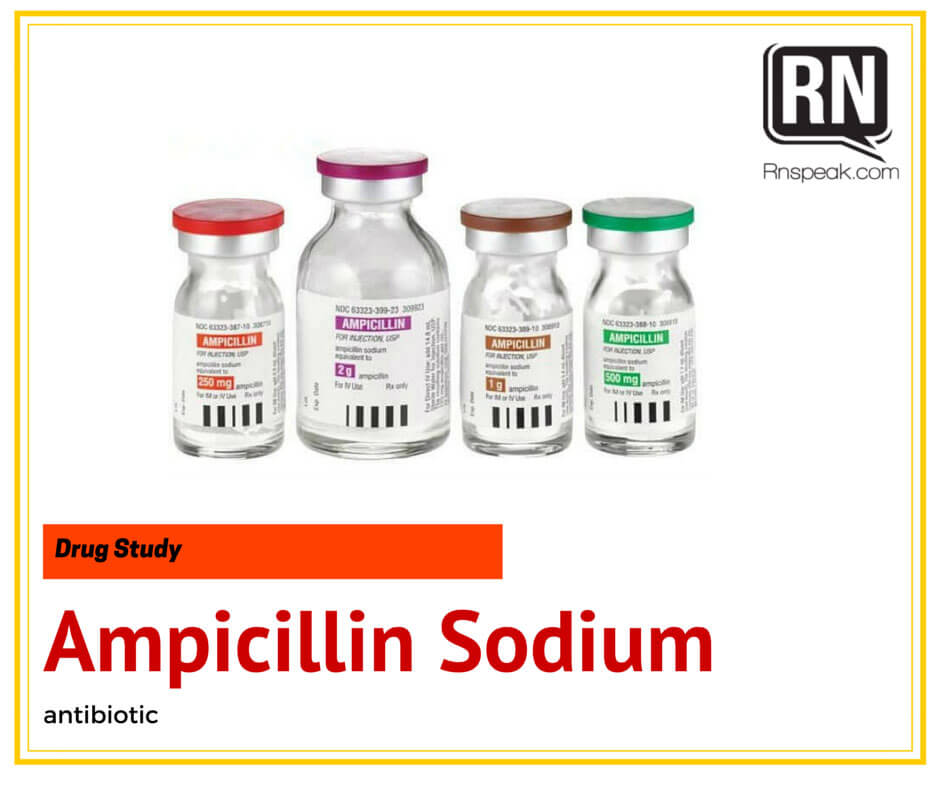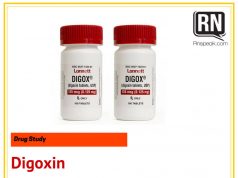
Generic Name: Ampicillin Sodium
Brand Name: Ampicin,Omnipen-N,Penbritin,Polycillin-N,SK-Ampicillin-N,Totacillin-N
Classifications: antiinfective; antibiotic; aminopenicillin
Pregnancy Category: B
Availability
250 mg, 500 mg capsules; 125 mg/5 mL, 250 mg/5 mL oral suspension; 125 mg, 250 mg, 500 mg, 1 gm, 2 gm vials
Actions
A broad-spectrum semisynthetic aminopenicillin, is highly bactericidal even at low concentrations, but is inactivated by penicillinase (beta-lactamase).
Therapeutic effects
Active against gram-positive microorganisms such as alpha- and beta-Hemolytic streptococci, Diplococcus pneumoniae, non-penicillinase producing Staphylococci, and Listeria. Major advantage over penicillin G is enhanced action against most strains of Enterococci and several gram-negative strains including Escherichia coli, Neisseria gonorrhoeae, N. meningitidis, Haemophilus influenzae, Proteus mirabilis, Salmonella (including typhosa), and Shigella. Inactive against Mycoplasma, rickettsiae, fungi, and viruses.
Uses
Infections of GU, respiratory, and GI tracts and skin and soft tissues; also gonococcal infections, bacterial meningitis, otitis media, sinusitis, and septicemia and for prophylaxis of bacterial endocarditis. Used parenterally only for moderately severe to severe infections.
Route & Dosage
Systemic Infections
adult: PO 250–500 mg q6 h
IV/IM 250 mg–2 g q6h
child: PO 25–50 mg/kg/d divided q6h
IV/IM 25–100 mg/kg/d divided q6h
neonate: IV/IM <=7 d & <=2000 g, 50 mg/kg/d divided q12h; <=7 d & >2000 g, 75 mg/kg/d divided q8h; >7 d, 50–100 mg/kg/d dividedq6–12 h
Meningitis
adultchild: IV 150–200 mg/kg/d divided q4–6 h
neonate: IV/IM <=7 d & <=2000 g, 100 mg/kg/d divided q12 h; <=7 d & >2000 g, 150 mg/kg/d divided q8h; >7 d, 100–200 mg/kg/d divided q6–12h
Gonorrhea
adult: PO 3.5 g with 1 g probenecid times 1
IV/IM 500 mg q8–12h
Administration
Oral
- Give with a full glass of water on an empty stomach (at least 1 h before or 2 h after meals) for maximum absorption. Food hampers rate and extent of oral absorption.
Intramuscular
- Reconstitute each vial by adding the indicated amount of sterile water for injection or bacteriostatic water for injection (1.2 mL to 125 mg; 1 mL to 250 mg; 1.8 mL to 500 mg; 3.5 mL to 1 g; 6.8 ml to 2 g). All reconstituted vials yield 250 mg/mL except the 125 mg vial which yields 125 mg/mL. Administer within 1 h of preparation.
- Withdraw the ordered dose and inject deep IM into a large muscle.
Intravenous
- Verify correct IV concentration and rate of infusion with physician for administration to neonates, infants, and children.
PREPARE direct: /intermittent: Reconstitute each 500 mg or less with at least 5 mL of sterile water for injection. Final concentration must be <=30 mg/mL; thus may be further diluted in 50 mL or more of NS, D5W, D5/NS, D5W /0.45NS, or RL. • Stability of solution varies with diluent and concentration of solution. Solution in NS are stable for up to 8 h at room temperature; other solutions should be infused within 2–4 h of preparation. Give direct IV within 1 h of preparation. • Wear disposable gloves when handling drug repeatedly; contact dermatitis occurs frequently in sensitized individuals.
ADMINISTER direct: /intermittent: Slowly over at least 15 min. • With solutions of 100 mL or more, set rate according to amount of solution, but no faster than direct IV rate. • Convulsions may be induced by too rapid administration.
Incompatibilities Solution / Additive: Any dextrose-containing solution, including parenteral nutrition solutions. Y-site: Clindamycin, erythromycin, aminoglycosides, lidocaine, verapamil.
Store capsules and unopened vials at 15°–30° C (59°–86° F) unless otherwise directed. Keep oral preparations tightly covered.
Adverse effects
BodyWhole: Similar to those for penicillin G. Hypersensitivity (pruritus, urticaria, eosinophilia, hemolytic anemia, interstitial nephritis, anaphylactoid reaction); superinfections.
CNS:Convulsive seizures with high doses.
GI:Diarrhea, nausea, vomiting, pseudomembranous colitis.
other:Severe pain (following IM); phlebitis (following IV);
Skin:Rash.
Nursing implications
Assessment & Drug Effects
- Determine previous hypersensitivity reactions to penicillins, cephalosporins, and other allergens prior to therapy.
- Lab tests: Baseline C&S tests prior to initiation of therapy; start drug pending results. Baseline and periodic assessments of renal, hepatic, and hematologic functions, particularly during prolonged or high-dose therapy.
- Note: Sodium content of drug must be considered in patients on sodium restriction.
- Inspect skin daily and instruct patient to do the same. The appearance of a rash should be carefully evaluated to differentiate a nonallergenic ampicillin rash from a hypersensitivity reaction. Report rash promptly to physician.
- Note: Incidence of ampicillin rash is higher in patients with infectious mononucleosis or other viral infections, Salmonella infections, lymphocytic leukemia, or hyperuricemia or in patients taking allopurinol.
- Take medication around the clock; do not to miss a dose; continue taking medication until it is all gone (usually 10 d) unless otherwise directed by physician or pharmacist.
Patient & Family Education
- Note: Ampicillin rash is believed to be nonallergenic and therefore its appearance is not an absolute contraindication to future therapy.
- Report diarrhea to physician; do not self-medicate. Give a detailed report to the physician regarding onset, duration, character of stools, associated symptoms, temperature and weight loss (if any) to help rule out the possibility of drug-induced, potentially fatal pseudomembranous colitis .
- Report S&S of superinfection (onset of black, hairy tongue; oral lesions or soreness; rectal or vaginal itching; vaginal discharge; loose, foul-smelling stools; or unusual odor to urine).
- Notify physician if no improvement is noted within a few days after therapy is started.
- Do not breast feed while taking this drug without consulting physician.







